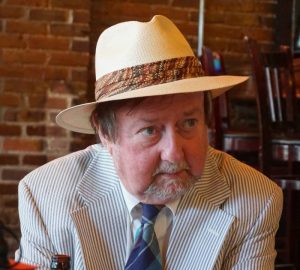Sam Brookes – Alumnus Spotlight
 retired Chief Archaeologist, USDA, National Forests in Mississippi
retired Chief Archaeologist, USDA, National Forests in Mississippi
Hometown: Jackson, MS
BA in Anthropology (1972)
LinkedIn
Why did you select anthropology as your major?
I attended junior college in North Carolina. After 2 years I still had no idea what I wanted to do in life. My favorite subjects were literature and biology. After working 2 years in a textile mill I realized all my spare time was spent looking for Indian artifacts and reading about such artifacts. I met a couple at church one Sunday who were students at Ole Miss and they told me about a great professor named Tom Koehler who taught anthropology/archaeology. I applied to Ole Miss and was accepted. I majored in anthropology with a minor in English and biology.
What were some significant experiences or fond memories of your time at UM?
My favorite memory of Ole Miss was my first archaeological excavation. Professor Koehler took us to MSU where we did a joint excavation with MSU Professor Richard Marshall. We worked at the Lyon’s Bluffsite, a late prehistoric village just outside of Starkville. That summer we were visited one day by Dr. James B. Griffin, the dean of North American archaeologists.
Please describe your educational/career path since graduation from UM.
After leaving Ole Miss in 1972, I accepted a job as an archaeologist with the Mississippi Department of Archives and History. I was stationed at a field office in Clarksdale. I worked in the Natchez Bluffs, Mississippi Delta, Gulf Coast, and the Tombigbee area of Northeast Mississippi. In 1985 I accepted a job with the Corps of Engineers in Vicksburg. I took the place of an Ole Miss grad and worked with 2 other archaeologists, also Ole Miss graduates. I worked in Mississippi, Louisiana and Arkansas. In 1987, I was hired as Chief Archaeologist for the National Forests in Mississippi. I was chagrined to realize I was in charge of 1.2 million acres of land and could not possibly handle the workload. We soon hired 6 archaeologists and stationed them on the various Ranger Districts in the Forest. I was in charge of the overall archaeological program and also did the archaeological fieldwork for Delta National Forest. When I was hired the National Forest had fewer than 50 sites located on the Forest. When I retired in 2011 over 10,000 archaeological sites had been recorded on the Forest.
What is the value of studying anthropology in today’s world?
Archaeology is a fun profession and I feel it will continue to be a necessary one. Federal and state laws require archaeological work to be done on significant sites that are threatened by construction and development. In retirement I give programs on archaeology and also, lead tours of Indian mounds. Ole Miss produced a number of archaeologists, many of whom are still working today. That first archaeological excavation back in the summer of 1968 produced 7 students who went on to become professional archaeologists; six from Ole Miss and one from MSU. And when I first arrived at Ole Miss in 1967, Professor Koehler told us about a mound that was dug in Louisiana. They got a C 14 date of around 5000 BC. That was way too early. The report on that mound was not published because the date was so early it was thought to be in error. Now we know that the site, Monte Sano, is the oldest mound in America. The report was finally published in 2019. I am one of the co-authors along with John Connaway (Ole Miss graduate) and the late Dr. William G. Haag (former Ole Miss Professor).
